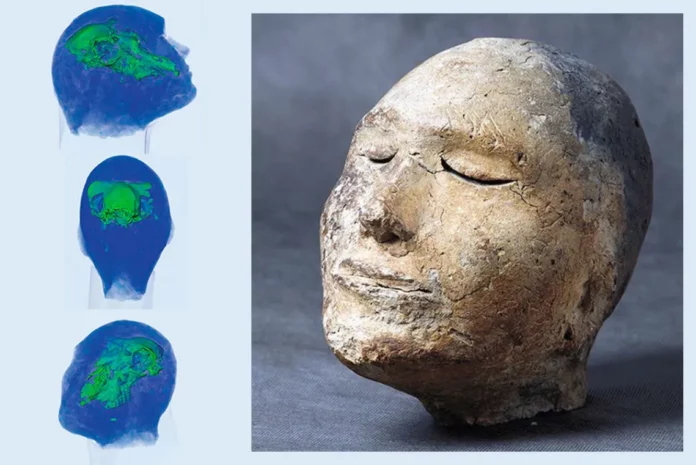According to a report from The Siberian Times, a team of Russian researchers has been able to examine the contents of a head-shaped sculpture made by Tagar Culture more than 2000 years ago after more than fifty years. There were no surprises.
In 1968 in Khakassia, Russia, a beautiful male clay funerary mask was discovered, inside a collective burial under a mound of the Shestakovsky cemetery. The find dates back to 2,100 years ago, and belonged to the Siberian Tagar culture of the Bronze Age. The artifact hid inside a real mystery that has only been possible to discover today.
The Tagar Culture
The Tagar were a Scythian people who inhabited southwestern Siberia between the 8th and 2nd centuries BC. They were known for raising cattle and their fine bronze metalworking. The landscape was marked by their large mounds.
The Changing Funeral Traditions
The burial practices of the Tagar culture evolved over time. Initially, the mounds were used to house high-status burials inside chamber tombs. However, in the fifth century BC, the mounds became larger and the chamber tombs were replaced with large pits capable of containing multiple bodies.
The Mystery of the Clay Mask
The clay heads discovered belonged to the final stage of Tagar culture, the Tesinsky stage. The remains found in the crypts of this period showed signs of attempted mummification. One particular clay mask caught the attention of Russian archaeologists as X-ray scans revealed something unusual inside. The scan identified bones within the clay head, but the size did not correspond to a human skull.
Unveiling the Mystery
The researchers decided not to open the clay artifact to preserve its integrity. Only recently, with the advancement of technology, they were able to use fluoroscopy to examine the hidden contents of the mask.
Fluoroscopy
Fluoroscopy is a radiological technique that provides real-time images of internal anatomy. It uses X-rays and a fluorescent screen to capture the attenuated X-rays passing through the body. The resulting images help visualize the internal structures.

The Revelation
The fluoroscopy revealed that the clay mask contained the skull of a sheep. This is the first time a non-human skull has been found inside a Tagar clay funeral head. The discovery raised questions about the significance of using a ram’s head instead of human remains.
Hypotheses
Professor Natalya Polosmak proposed two hypotheses to explain the practice. First, the Tagar people may have buried individuals who had not been found, replacing them with animal remains to ensure their journey to the afterlife. Second, the use of animal remains could symbolize a new beginning or a different status for the deceased.
Elaborate Burial Rites
Dr. Elga Vadetsakaya proposed a third hypothesis based on her study of the burial rites during the Tesinsk period. She suggested that the clay heads were part of a two-phase burial process, involving partial mummification and later burial in a large pit. The clay heads represented the deceased and allowed families to recreate their appearance if the original remains were decomposed or damaged.
Conclusion
The discovery of the sheep skull inside the Tagar clay mask offers insights into the burial practices and beliefs of the Tagar culture. While the exact reasons for using animal remains remain uncertain, further research and technological advancements may shed more light on this intriguing artifact.
Share your thoughts and opinions on the Tagar culture and the theories presented. We are eager to hear your perspective!
